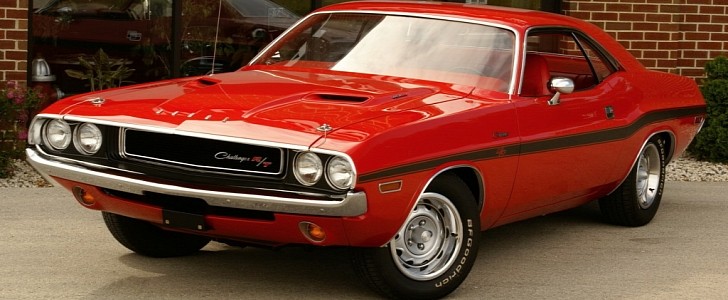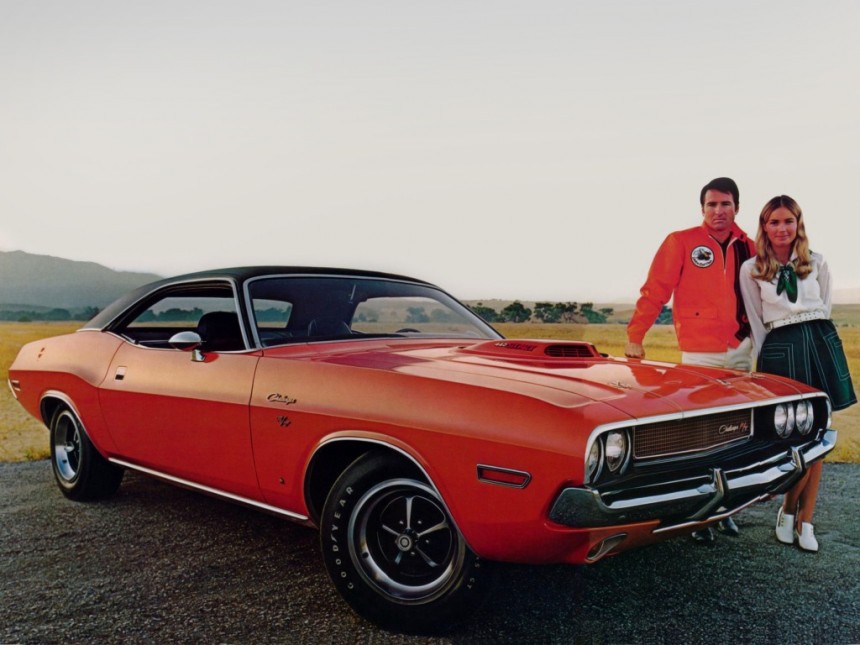Effortlessly cool. That’s what comes to mind whenever I see a well-sorted example of the original Challenger that entered production in the fall of 1969 for the 1970 model year. Larger than both the Mustang and Camaro, the E-Body muscle car twinned with the Plymouth Barracuda takes its name from the Coronet-based Dodge Silver Challenger special edition.
Slightly longer and more spacious than its Plymouth-branded sibling, the Challenger sold just over 83,000 units in the first year of production. Originally offered as a two-door hardtop and a convertible, this iconic machine was positioned to compete against Mercury’s Cougar and the Pontiac Firebird. The Dodge brand really did its homework in this regard by offering a range of nine powertrain options, starting with an anemic inline-six.
The 225ci Slant-Six had 145 horsepower to offer, which is very underwhelming by everyone’s account. This rating is made worse by the gross measurement of horsepower. In other words, the figure was taken from an engine running on a stand without accessories, the air cleaner assembly, or the exhaust system. The next level up came in the guise of the LA 318 with 230 horsepower on tap, followed by the LA 340 that cranked out 275 horsepower as standard and 290 horsepower in the T/A.
Things get properly interesting with the 383 from the B engine family, a venerable design offered with up to 335 horsepower. Customers who needed a little more oomph could specify the 440 from the RB engine family with up to 390 HP and a similar torque figure to the Street HEMI.
Named after the hemispherical combustion chambers, the 426 is notorious for noisy lifters and the rough idle when cold. With the help of hindsight, it’s obvious the 426 was actively pushed by the marketing peeps for its halo effect, while the RB 440 was the better choice for daily-driving scenarios.
In terms of driveline bits and pieces, the Dodge Challenger was offered with three- and four-speed manuals that could be fitted with a Hurst pistol-grip shifter. The Chrysler TorqueFlite automatic needs to be mentioned as well, along with a heavy-duty Dana 60 rear differential for the big-block mills.
The first year of production featured a grand total of four trims: base, SE for Special Edition, R/T for Road and Track, and T/A for the Trans-Am racing series. A lower-than-base trim level by the name of Deputy was introduced mid-year, and West Coast dealers had the Western Sport Special to call their own. The most famous 1970 model of them all is the R/T driven by Kowalski in the high-octane action movie Vanishing Point from 1971.
New emission standards led to powertrain changes for the 1971 model, which also saw the Challenger pace the Indianapolis 500. From the standpoint of design, the biggest differences came in the form of revised taillights, and a twin-inlet grille painted silver on standard variants and black on the R/T. The Road and Track was treated to fiberglass quarter-panel louvers while the convertible R/T was axed. Dodge also discontinued the SE and T/A trims, with the latter no longer racing in the Trans-Am championship.
Come 1972, the Challenger found itself between a rock and a hard place due to the switch to unleaded gasoline and rising insurance rates. The third year of production saw Dodge adjust the output ratings from gross to net, reducing the previous ratings by anything between 20 to 30 percent. 1972 also marked the discontinuation of the convertible. A redesigned front grille with an egg-crate aesthetic, the Rallye trim level serving as a successor to the R/T, and twin taillights on each side also need to be mentioned. That year, the 340-cubic-inch V8 mill topped the list with 240 HP.
1973 signaled the beginning of the end for the Dodge Challenger due to five-mile-per-hour bumpers equipped with unappealing rubber guards. The inline-six was dropped from the range, leaving only the 318 and 340 V8s.
For the final year of production, the primary difference over the 1973 MY was the way the shoulder and lap belts operated. The inertia reel and federally-mandated seatbelt ignition interlock led the list of changes, along with the LA-family 360 engine that replaced the smaller 340.
April 1974 is when production of the original Challenger came to a screeching halt. Approximately 188,600 units were made over the first generation’s life cycle in Hamtramck (Detroit) and in the City of Angels.
The 225ci Slant-Six had 145 horsepower to offer, which is very underwhelming by everyone’s account. This rating is made worse by the gross measurement of horsepower. In other words, the figure was taken from an engine running on a stand without accessories, the air cleaner assembly, or the exhaust system. The next level up came in the guise of the LA 318 with 230 horsepower on tap, followed by the LA 340 that cranked out 275 horsepower as standard and 290 horsepower in the T/A.
Things get properly interesting with the 383 from the B engine family, a venerable design offered with up to 335 horsepower. Customers who needed a little more oomph could specify the 440 from the RB engine family with up to 390 HP and a similar torque figure to the Street HEMI.
Named after the hemispherical combustion chambers, the 426 is notorious for noisy lifters and the rough idle when cold. With the help of hindsight, it’s obvious the 426 was actively pushed by the marketing peeps for its halo effect, while the RB 440 was the better choice for daily-driving scenarios.
In terms of driveline bits and pieces, the Dodge Challenger was offered with three- and four-speed manuals that could be fitted with a Hurst pistol-grip shifter. The Chrysler TorqueFlite automatic needs to be mentioned as well, along with a heavy-duty Dana 60 rear differential for the big-block mills.
The first year of production featured a grand total of four trims: base, SE for Special Edition, R/T for Road and Track, and T/A for the Trans-Am racing series. A lower-than-base trim level by the name of Deputy was introduced mid-year, and West Coast dealers had the Western Sport Special to call their own. The most famous 1970 model of them all is the R/T driven by Kowalski in the high-octane action movie Vanishing Point from 1971.
Come 1972, the Challenger found itself between a rock and a hard place due to the switch to unleaded gasoline and rising insurance rates. The third year of production saw Dodge adjust the output ratings from gross to net, reducing the previous ratings by anything between 20 to 30 percent. 1972 also marked the discontinuation of the convertible. A redesigned front grille with an egg-crate aesthetic, the Rallye trim level serving as a successor to the R/T, and twin taillights on each side also need to be mentioned. That year, the 340-cubic-inch V8 mill topped the list with 240 HP.
1973 signaled the beginning of the end for the Dodge Challenger due to five-mile-per-hour bumpers equipped with unappealing rubber guards. The inline-six was dropped from the range, leaving only the 318 and 340 V8s.
For the final year of production, the primary difference over the 1973 MY was the way the shoulder and lap belts operated. The inertia reel and federally-mandated seatbelt ignition interlock led the list of changes, along with the LA-family 360 engine that replaced the smaller 340.
April 1974 is when production of the original Challenger came to a screeching halt. Approximately 188,600 units were made over the first generation’s life cycle in Hamtramck (Detroit) and in the City of Angels.



























